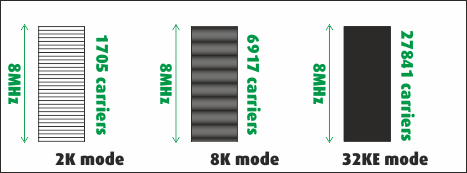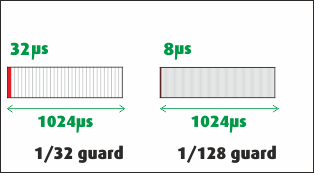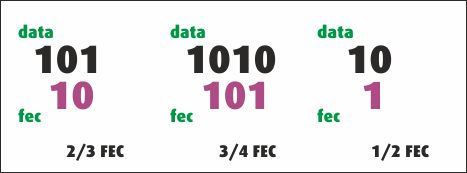Freeview modes - a simplified explanation
 Brian Butterworth published on UK Free TV
Brian Butterworth published on UK Free TV As mentioned in How digital television works Freeview signals can be broadcast in a number of different "modes", which are a combination of five parameters. Some of these have changed over the years because the increase in computing power has made more efficient methods of broadcasting cheap enough to fit in a set-top box - it is now possible to broadcast high definition television or more standard definition services on the same physical wavelength.
As some of the ideas that are implemented would fill a text book by themselves, I have presented the concepts in a simplified way.
Sub-carriers
Each Freeview multiplex is broadcast within an 8MHz channel that was originally allocated to analogue television. Rather than being a single broadcast, the channel is split into a number of different signals that sit next to each other.The original digital terrestrial broadcasts (from the launch of ONdigital) used 1,705 sub signals (referred to as 2k mode) about 4,600 Hz apart. After switchover 6,817 subcarriers (8k mode) means the signals are 1,170 Hz apart, with the high definition service using 27,841 (32ke) subcarriers just 280Hz apart.

It is possible to space carriers so close together because they are carrying digital information, in the analogue domain the problem with sidebands would render a similar system useless.
Symbol duration
For reasons detailed below, the information is not transmitted in single bits on each carrier, but as groups of bits which are referred to as "symbols". Each symbol is held in the transmission system for a given duration, 1024 us. The longer this time is, the less information is carried, but too short a duration for each symbol would not allow the receiver to detect the information correctly.Guard interval
Each subcarrier also uses a guard interval, which turns off each carrier as part of the transmission cycle. With SD broadcasts, this is 1/32th of the symbol time (32us), on HD it is 1/128th (8us). The guard intervals start each symbol and exist to deal with the problems of multipath - where the signal is being received directly and also by reflections.
Forward error correction
In non-synchronous digital transmission systems, such as those used for the internet, the presence of data corruption between the sender and receiver can be signalled back to the source and the data resent.However, a digital broadcast is a one-to-many unidirectional system, with no ability to ask for data to be resent.
For this reason, the transmissions use "forward error correction", which is a system that allows a certain level of errors to be detected.
The most basic form of a forward error correction (FEC) would be to transmit each bit twice - as long as each bit was sent along a separate subcarrier, then a single bit loss on one carrier could corrected by using the one sent on the other carrier. However, this is very inefficient, as it reduces the useful capacity of the system by half.

So, instead the DVB-T system uses a Punctured Convolution coding system. Instead of sending each bit twice, bits are grouped and then a code that describes the bits in a way that a single bit error can be detected and corrected most of the time.
Quadrature amplitude modulation
In the above descriptions, the word "symbol" was used to describe what is transmitted. You may have thought that a digital system would transmit information on the subcarriers as bits. However, doing this in a broadcast system is actually unproductive.For this reason, quadrature amplitude modulation is used. This takes the incoming bits and encodes them in groups. The most basic form encodes bits two at a time, using sine (Q) and cosine (I) functions that are then added to the main carrier. In effect "00" is encoded as -Q-I, "11" as +Q+I, with "01" and "10" being +Q-I and -Q+I.

At the next level, as used for DVB-T, the bits are encoded in groups of four bits (16QAM) or eight bits (64QAM), with DVB-T2 being groups of 16 bits (256QAM).
UK Freeview modes
There are 10 modes defined for use in the UK, these are:- Mode 1: DVB-T 1705 (2K) carriers, 64QAM mode, FEC=2/3, 1/32 guard = 24.13Mbps
- Mode 2: DVB-T 1705 (2K) carriers, 16QAM mode, FEC=3/4, 1/32 guard = 18.1Mbps
- Mode 3: DVB-T 6817 (8K) carriers, 64QAM mode, FEC=2/3, 1/32 guard = 24.1Mbps
Mode 4: DVB-T2 6913 (8KE) carriers, 64QAM mode, FEC=4/5, 1/32 guard = 34.7MbpsunusedMode 5: DVB-T2 27841 (32KE) carriers, 256QAM mode, FEC=3/5, 1/128 guard = 36.1Mbpsunused- Mode 6: DVB-T2 27841 (32KE) carriers, 256QAM mode, FEC=2/3, 1/128 guard = 40.2Mbps
- Mode 7: DVB-T 6817 (8K) carriers, QSPK mode, FEC=1/2, 1/32 guard = 6.0Mbps
- Mode 8: DVB-T 6817 (8K) carriers, 64QAM mode, FEC=3/4, 1/32 guard = 27.1Mbps
"high capacity commercial multiplex mode". Mode 9: DVB-T2 27265 (32KN) carriers, 256QAM mode, FEC=3/5, 1/128 guard = 35.2Mbpsunused- Mode 10: DVB-T2 27265 (32KN) carriers, 256QAM mode, FEC=2/3, 1/128 guard = 39.2Mbps
- Mode 11: "Northern Ireland mode" details TBC
Diagram showing capacity for each mode:

Help with Television sets?
Wednesday, 4 January 2023
C
Chris.SE11:53 PM
Gordon palmer:
I would have thought it highly unlikely that your new tv requires a much stronger signal. Also depending on the signal strength you do get, using an aerial amplifier might overload your receiver which can lead to all sorts of unexpected issues as the receiver can be "de-sensitised".
I get conflicting results from different predicted reception checkers for some postcodes that can receive Brougher Mountain so without having any idea about your predicted reception, for which we need a full postcode, it's almost impossible to suggest potential causes of your problem other than obvious standard checks.
Apart from that full postcode, it would be useful to know what the indicated Signal Strength and Quality (or Error/BER) figures are WITHOUT the amplifier for each of the multiplexes RF channels. Also try a manual tune on RF C21, sometimes auto-tuning can miss a weaker signal..
Obvious basic checks are look at your aerial and check it's still intact and pointing in the correct direction and that the downlead isn't flapping in the wind. Recent strong winds may have resulted in it moving or being damaged. If the downlead terminates in a wall-plate check for connection, water & corrosion problems behind it. Check your coax plug connections for bad or short connections etc. Such problem don't always appear to affect all RF Channels due to standing waves that can get set up in the cable which can make a particular channel very weak or one appear exceptionally strong.
| link to this comment |
Wednesday, 28 June 2023
these people who have just got round to buying a freeview box and are having reception problems they didnt get with the analoguge channels will have to come to terms with needing a new uprated tv aerial,constructed in the digital format.see an expierienced installer and ask questions.
| link to this comment |
Chris.SE: so what frequecies are the latest digital aerials tuned to recieve , in lancs we are on winter hill channels starting at 21 and some still at 55 .
the aerials we are buying from the wholesalers are made in china and i m not convinced they are tuned for the right channels, it says on the label21 to 50 at the moment but other makes have wider and different spaced elements , how are we to know what we should use , ive been experimenting with home made twigs ive cogdged up for my test bench but nothing is coming up positive as being best
| link to this comment |
C
Chris.SE1:45 PM
alan hobson:
Oh dear. In the old analogue days you never heard of "continental interference" which we used to get fairly frequently in summer? In the old 405-line days it was Sporadic-E (lower frequency band - band I).
In bands II/III/IV/V (DAB is also affected) by what is "Tropospheric Ducting" the results can be similar - there are many DXers in the E and SE in particular who've been receiving foreign DTV and DAB and FM due to recent weather conditions! Both the BBC and Freeview have put out warnings when such conditions may affect a larger number of viewers.
Next, there is NO such thing as a "digital" aerial. Aerials are aerials that receive RF signals they don't care whether the modulation is digital or analogue. Sellers that call them "digital" are mostly those that just sell and assortment of things, no experience in reception or installation.
Since 700MHz Clearance and the closure of the last of the temporary COM7/8 muxes, there is no transmitter in the UK broadcasting on channels above C48. Final European ones on C55/56 are due to close/move soon. If you are referring to the details on the Winter Hill page on this site, two local muxes haven't been updated - I've repeated a post, the content of which has been posted a few times around this site.
The "problem" with Winter Hill (not the only one) was that it was originally in aerial group C/D. Now the main channels are in Group A (just) but a Group K aerial would be better depending on location and Local mux reception. Anyone with an old C/D aerial (depending on local signal strength) will possibly struggle with reception of the lower frequencies. The issue was addressed during the clearance programme by simulcasting the BBCA multiplex on C32 (started in Feb.2020) as well as it's original C50. Anyone who had no/unreliable reception of C32 could apply for the fairly well advertised FREE help for a new aerial. That simulcast timescale was extended until Aug.2020 before completion of the changes because of covid-19, so there was plenty of time to get he free help. Only a few cowboy installers did not tell people about the free help, though it was well advertised in/on local media.
Anyone buying a new aerial these days should buy a Group K (21-48) unless all their UHF channels are in Group A or B, though in a number of cases many Group K aerials perform better.
There are even Group K and Group A log periodics.
For some information about log-periodics, the Wiki article gives a good basic understanding as does the article from Don Valley Aerials.
Log-periodic antenna - Wikipedia
The log periodic | Don Valley Aerials
There's a BBC R&D article which I haven't has time to read but will no doubt be interesting -
A UHF log-periodic receiving aerial - BBC R&D
If you buy or use a Group T/wideband (or any aerial that receives above C48) then if a new/updated mobile mast starts close enough to you, you may suffer interference from them if they use the 700MHz band. You should be notified by a postcard from Https://restoretv.uk if you may be affected, but we are aware of cases where people haven't been. Where you have that problem, you can get a free filter from them.
Good aerial design is a complex matter, unless you love experimenting, then buy a suitable quality aerial.
Why are you buying Chinese made aerials if you don't want them? - There are UK manufacturers! But perhaps what is more important is the design and quality of the product. Eg. take a look at Aerials: TV, Radio, Wifi, 4G & 5G - Blake UK
You may also take a look at eg. A.T.V. Poles, Brackets, Clamps & Aerials Established 1994. who have an excellent reputation for quality products and technical information.
There are other UK Retailers/Wholesalers that sell quality products as well as UK made ones.
| link to this comment |
Select more comments
Your comment please!